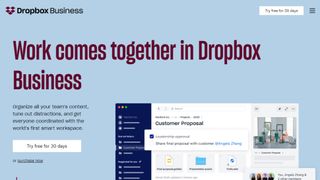
Starting up a small business can seem a scary proposition, and it’s often difficult at first to know what software you will need.
While there are obvious basics, such as productivity suites and accounting platforms, it’s always possible that something can take you by surprise. That’s why it’s good to have a general idea of what different types of software are out there, so that the moment you identify a need, you can also identify a solution.
This is especially the case when you start to grow and find yourself wanting to communicate and collaborate with new employees, customers, or suppliers.
Luckily, there is a lot of competition online in the software market, and while there are big name products priced for big name clients, there are always smaller and cheaper packages which can be just as good. The challenge is to find not just the type you need, but the one that comes in at the right price for you.
However, even some of the more seemingly expensive software suites sometimes have a free tier, so you can try it out and see if it works for you – and if it does, you can grow into the software as your business cashflow improves.
Even better is that sometimes there are free alternatives to paid-for brand name suites, though often it’s the case that you get what you pay for, and cheap or free can come with limitations.
We’ll therefore look to list a wide range of software types that it’s good to be familiar with, and feature the best on the market, so that should you develop a need for anything in particular, you already have an idea of what to look for.
- We’ve also picked out the best small business web hosting
- Want your company or services to be added to this buyer’s guide? Please email your request to [email protected] with the URL of the buying guide in the subject line.
Best software for small business – at a glance
- Office 365
- Xero
- Dropbox Business
- Asana
- Slack

1. Office 365
The original and best office suite software
There are many rivals, but Microsoft Office is still the best office software suite, and Office 365 delivers a cloud version you can use on the go as well as at home or in the office.
The first thing going for Office 365 is its familiarity – if you’ve used Microsoft Office before you’ll find most of it very familiar. Even if you haven’t and have used rivals instead the same still applies because Microsoft Office is the market leader that others attempt to copy.
The second is that Office 365 works in the cloud, which offers several advantages, the first being that you can use it on the go with your smartphone or tablet, but the second being that all your documents are saved online in the cloud with OneDrive. This means you don’t have to worry about losing important files to a harddrive crash, and also that you can switch between devices without losing your work.
Pricing can seem a little more expensive than it used to be for buying a standalone license, and starts from $6.99 per month for Office 365 Personal, which provides you with Word, Excel, Powerpoint, Publisher, and Access, with online emails served by Outlook, and OneDrive for cloud storage of documents.
There’s also Office 365 Home which offers up to six licenses for $9.99 a month, which could be ideal and cost-efficient for distributing around employees if you have five or less. Office 365 Business Premium is targeted at larger businesses and includes Sharepoint, Micrososft Exchange, and Micrososft Teams for $12.50 per user per month.
Altogether, Office 365 delivers what you need and remains superior in terms of functionality than rivals. Additionally, expect to find many suppliers and contractors to also using it, making it an ideal fit for any small business.
- You can sign up for Microsoft Office 365 here

2. Xero
Sort out your finances
You’ll find no shortage of finance applications out there with small businesses firmly in their sights, and there are plenty of excellent ones besides Xero – but we’ve chosen this product for its overall comprehensiveness, mix of accessibility and advanced features, and the smart way in which it works. On the downside, it’s one of the more expensive options.
What Xero does best is switch between the complex and the simple effortlessly – so you can (for example) set up an automated report showing exactly where all your spending has gone this year, broken down by category; or you can just bring up a bar chart of how much money is coming in each month. Or both.
The app is also very customizable, giving you the opportunity to bring up the features and statistics that you need, and hide the ones you don’t. We wouldn’t recommend it for the smallest and simplest businesses, because it’s too sophisticated and expensive for that, but as your business grows and grows, Xero will be able to keep pace.
Plus, as you would expect for something at this price, it’s packed with extras beyond the basics of just checking on your incomings and outgoings. Xero is able to automatically pull in bank feeds, work in multiple currencies, allow different users into your account with different levels of access (so your accountant can file your tax returns for you), and much more besides.
- You can signup to Xero here

3. Dropbox Business
The ultimate file sync service
Dropbox was perfecting file syncing across the cloud and multiple devices long before Google, Apple and Microsoft got their respective acts together, and it’s this syncing functionality that remains at the core of what Dropbox does, even as it has added a few extra strings to its bow.
If you need to do anything at all with files, then Dropbox is just about the best way to do it – share large files over the web, get at your office documents from home, give certain team members access to a certain folder, stream video from a computer to a web browser, collaborate on the same file with a lot of people… the list goes on.
The simple and efficient clients that Dropbox has for just about every platform and device out there certainly help, as does the recently revamped (and rather beautifully designed) web interface. If you need to password-protect folders, or set expiry dates for the files and folders you share, then Dropbox can do all of that too.
Its Paper app for collaborating on documents is worth a look too, even if it’s not quite up to the standard set by G Suite – you’ll find it’s clean, simple to use, and lets multiple people get together on a document without any fuss at all.
- You can signup to Dropbox here

4. Asana
Project management perfection
Got both a team and multiple projects to manage? Asana helps you work out who should be doing what at any given moment, maximizing the chances of everything coming together on deadline (though you do need a certain amount of talent and hard work from your staff as well, of course).
As with the other software tools in this list, it’s not just the features that Asana has that make it special – it’s the way those features are wrapped up in an elegant and accessible interface that’s easy to navigate around and works across mobile apps and the web without missing a beat.
We also like the way Asana integrates very well with more than a hundred other products and services. All the big names are included – Dropbox, Slack, Gmail, Salesforce and so on – and this means Asana is flexible enough to fit right into whatever workflow you’ve got set up at the moment (or want to try in the future).
Whether you’re mapping out the steps in a project, assigning duties and responsibilities, checking on the current status of a plan or trying to get a ‘big picture’ look at exactly what’s happening at any given moment, Asana makes the process much more straightforward than you might expect.
- You can signup to Asana here

5. Slack
Transform team communication
Believe the hype, or at least part of it – Slack may not have killed off email just yet, and it can turn into a time sink if you’re not disciplined in how it’s deployed, but it’s also fair to say that this communications platform has helped transform the way that a lot of small business teams keep in touch.
Like all the best software tools, the basic idea is very simple: real-time messaging in web browsers, mobile apps, and desktop clients. Team members can chat one to one, or in groups, or in channels based around topics (sales, finances, products and so on).
What Slack does well though is bring that simple idea to life very intuitively, with a slick and responsive interface, and a host of integrations, plug-ins and shortcuts to keep the conversation flowing. All the functions you think you might need, from file transfers to video calling, are right there for you.
You don’t get much out of Slack for free – with 5GB of total storage, 10,000 recent, searchable conversations and no group calling – but it gives you a feel for the app, and should be fine for smaller teams. At the highest pricing tier, you get round-the-clock support and a guaranteed support response time of four hours, as well as unlimited message archives.
- You can sign up to Slack here

Image Credit: Pixabay
Other small business software to consider
We’ve barely touched the surface of all the different software options a small business might want to consider, not least as there are multiple areas of interest and a strong range of competitors who want to offer the best product for you. However, here are a few more that get honorable mentions, either because they’re positioned so well in their respective industries, or they offer a wider ranger of features-and all of them geared toward small businesses:
Paypal is a long-established merchant gateway provider for taking online payments, and has since moved into physical retail as well as pay and go mobile card readers. All of which means that if you need a payment provider, Paypal can cover you well, no matter what sort of business you have. There’s no monthly fee for the basic plan, which will cover online ordering, which helps reduce upfront fees. And once you’re well established with a good sales volume and turnover, if you’d prefer to cut down transaction fees then you can switch to a merchant account where for a monthly fee upfront you’ll pay mostly interchange rates on each transaction.
Salesforce is possibly the leading sales solution for businesses of many sizes. Whether you’re looking to focus on online or offline marketing, telephone or email sales, then this is an all-in-one platform that aims to bring customer sales and relationships together. However, it’s not just about logging numbers and ticketing as much as improving all-round efficiency. This means you can look to improve key metrics across all processes, not least your sales and CRM channels, ensuring both a good synchronicty and efficiency between them.
Zoho provides so many different software and apps for small business the bigger question might not be what they do, but what they don’t. Zoho provides such a comprehensive range of solutions that it’s impossible to due the company justice here, suffice to say that they-currently-provide at least 45 apps covering everything from sales, help desk, finance, people, IT, office, project management, and collaboration. What’s even better is that not only do these all integrate with each other, but also often integrate with other popular business software platforms. If you need to do something, Zoho probably have already released software to do it!
Adobe Apps is probably another toolkit to consider here, not least because of Adobe’s real strengths in creativity and design, as well as PDF management-something every business will have to address at some point. Adobe sell different apps in different groups, however, so it’s important to ensure you’re looking at the correct set. However, don’t be surprised if you end up susbscribing to multiple apps, not least the creativity bundle that includes Photoshop, and Adobe Acrobat for creating, editing, annotating, and signing PDF files.
[“source=techradar”]
